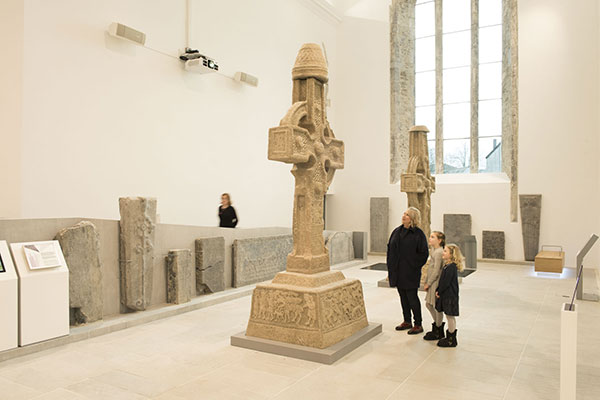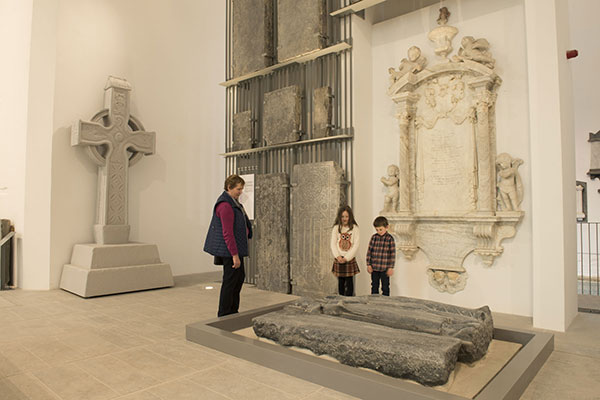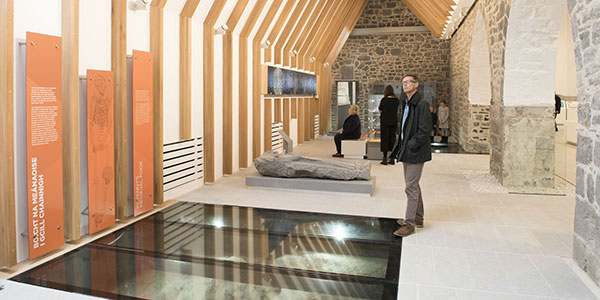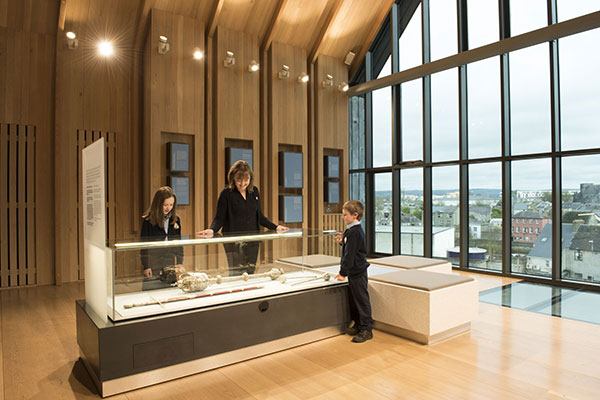Medieval Mile Museum
Published in Anglo-Norman Ireland, Issue 5 (September/October 2017), Medieval History (pre-1500), Reviews, Volume 252 St Mary’s Lane, High Street, Kilkenny
www.medievalmilemuseum.ie
By Tony Canavan
Kilkenny’s newest museum is located in one of the city’s oldest buildings, St Mary’s Church, dating back to the twelfth century. There is no attempt to hide the building’s origins and the visitor is aware of being in a former church. The main structure is visible, and around the walls are the memorial plaques commemorating past citizens of Kilkenny. The floor has reinforced glass panels through which you can see the remains of the original medieval foundations.
What have been added are a number of interactive displays and artefacts outlining Kilkenny’s history. The first is a long, waist-high cabinet containing a map of the city. On top of this is a representation of the eighteenth-century Rocque map of Kilkenny. Remarkably, you can manipulate and move this map around, allowing you to focus on particular features or orientate the map in different ways. This complements the other map beneath, which portrays the medieval mile of the museum’s name. This, too, is interactive, enabling the visitor to discover aspects of the history of sites on the mile simply by tapping on the screen. For example, you can tap on St Mary’s Church to learn that it was founded in the twelfth century by the Anglo-Norman lord William Marshal and that it witnessed the major events in the city’s history and underwent a number of changes before reaching its present form. As with everything else in the museum, text is available in either Irish or English.

Above: Coming out of the chapel, you can’t miss the two large replica high crosses.
Nearby is the Reflecting Well. This is a tub-like box apparently containing water. When you bend over to look inside, however, the water recedes as if by magic and key moments in Kilkenny’s history, from the kingdom of Ossary to more recent times, appear before you. This is a great way of conveying over 1,000 years of history and giving it a human face, as characters from Kilkenny’s past ‘appear’ and talk in front of you. This is just one of the many clever interactive devices to be found in the museum.

Above: You could spend some time studying the many memorial plaques around the walls and the grave-slabs that are on display.
The museum is more than just a hi-tech show, however. There are actual objects too. You could spend some time studying the many memorial plaques around the walls and the grave-slabs that are on display. For example, there is one carved gravestone dating from the fourteenth century, which was later used to cover the grave of Jacobus Clerr in the sixteenth century. Not far away is a slab depicting a man and woman from the 1300s. Although the carving is fine and details on the clothing clear, the couple remain unidentified.
Stepping out of the main gallery, you go into the Rothe Chapel, named after a family of influential merchants, which celebrates their wealth as much as their devotion to the church. The Rothes built the chapel, officially dedicated to St Michael the Archangel, around 1560, and the carvings on their tombs provide an insight into the lives of these powerful merchants.
Coming out of the chapel, you can’t miss the two large replica high crosses standing across the way. These date back to the heyday of the kingdom of Ossary and are a reminder that this region was important even before the Normans arrived. There is plenty of information on the crosses, their associations with St Canice, their construction, and the long tradition of stone-carving in the Marble City.

The floor has reinforced glass panels through which you can see the remains of the original medieval foundations.
From here, the visit takes you upstairs. From the stairs you can look out onto the cemetery that once surrounded the church. Featuring gravestones and cloisters, it is worth exploring when you have finished with the museum. At the top of the stairs you come out into the Kilkenny Room, which concentrates on municipal history. It has an impressive view over the city, but you will immediately notice the large silver sword and maces, granted by royalty and once the symbols of the authority of Kilkenny’s corporation. Along one wall are what look like lockers. Inside these are documents relating to the corporation, so delicate that they cannot be exposed to daylight. In one, for example, is a record book from 1547, the open page referring to punishments meted out to wrongdoers, such as the ducking-stool and the whipping-post.
Elsewhere in this room are royal charters from Edward II, James I and James II, along with an order from William of Orange restoring the ‘Protestant’ corporation that had been abolished by James II. As well as this there are records, original documents and books from Kilkenny’s corporation through the centuries.

Above: The Kilkenny Room has an impressive view over the city. You will immediately notice the large silver sword and maces, granted by royalty and once the symbols of the authority of Kilkenny’s corporation.
If you did not already know how historic Kilkenny is, you certainly will after visiting this museum. It combines the best in up-to-date technology with ‘hard’ artefacts to tell a story that is entertaining and informative. I have only skimmed the surface in this article, but as I walked back to my car I looked at the streets and buildings of Kilkenny in a new light.
Tony Canavan is the editor of Books Ireland.
















